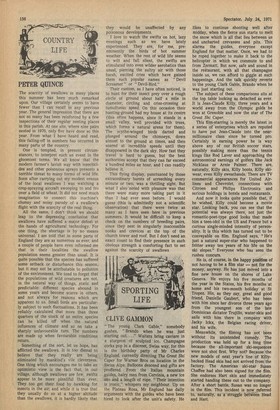PETER QUINCE
The scarcity of swallows in many places this summer has been much remarked upon. Our village certainly seems to have fewer than I can recall in any previous year. The general impression that there are not so many has been reinforced by a few inspections of their regular nesting places in this parish. At one site, where nine pairs nested in 1970, only five have done so this year. From what I have heard and read, this falling-off in numbers has occurred in many parts of the country.
One is tempted, in present circumstances, to interpret such an event in the gloomiest terms. We all know that the modern farmer's lavish way with insecticides and other poisonous sprays presents a terrible threat to many forms of wild life. Soon after carrying out my modest census of the local swallows I was watching a crop-spraying aircraft swooping to and fro over a field of wheat. It did not need much imagination to connect this machine's clumsy and noisy parody of a swallow's flight with the scarcity of the real thing.
All the same, I don't think we should leap to the depressing conclusion that swallows have suffered a major defeat at the hands of agricultural technology. For one thing, the shortage is by no means universal. I am told that in some parts of England they are as numerous as ever, and a couple of people have even informed me that in their localities the swallow population seems greater than usual. It is quite possible that the species has suffered some setback or disturbance this season, but it may not be attributable to pollution of the environment. We tend to forget that the populations of wild creatures are not, in the natural way of things, static and predictable: different species abound in some years and become scarce in others, and not always for reasons which are apparent to us. Small birds are particularly subject to such fluctuations. It has been reliably calculated that more than three quarters of the stock of an entire species can be killed off when the natural influences of climate and so on take a sharply unfavourable turn. The numbers are made up when favourable conditions return.
Something of the sort, let us hope, has afflicted the swallows. It is too dismal to believe that they really are being eliminated by mankind's vile cleverness. One thing which encourages me to take an optimistic view is the fact that, in our village, although swallows are few, swifts appear to be more plentiful than ever. They too get their food by hawking for insects in the air; and while it is true that they usually do so at a higher altitude than the swallows, it is hardly likely that they would be unaffected by any poisonous developments.
I love to watch the swifts on hot, lazy evenings such as we have lately experienced. They are, for me, preeminently the birds of hot summer weather. When the rest of wild life seems to wilt and fall silent, the swifts are stimulated into even wilder aerobatics than usual, piercing the sultry air with those harsh, excited cries which have gained them such popular names as "Devil Screamer " or " Devil-Bird."
Their custom, as I have often noticed, is to hunt for their insect prey over a rough circle of ground about half a mile in diameter, circling and criss-crossing at tumultuous speed. On this occasion their hunting-ground had my house at its centre (this often happens, since it stands in a small valley, well provided with trees, which forms a natural arena for them). The scythe-winged birds darted and plunged around the chimneys, down almost to the ground at times, and then soared at incredible speeds until they disappeared in the dark sky. How fast they travel is hard to guess, but the best authorities accept that they can far exceed a hundred miles an hour, and I can readily believe it.
This flying display, punctuated by those extraordinary bursts of screeching every minute or two, was a thrilling sight. But what I also 'noted with pleasure was that there were many more taking part in it than I had ever seen before. I would guess (this is admittedly not a scientific observation) that there were twice as many as I have seen here in previous summers. It would be difficult to keep a check on the numbers of breeding pairs, since they nest in singularly inaccessible nooks and crevices at the top of the church tower and roof. But I don't need an exact count to find their presence in such obvious strength a comforting fact to set against the scarcity of swallows










































 Previous page
Previous page